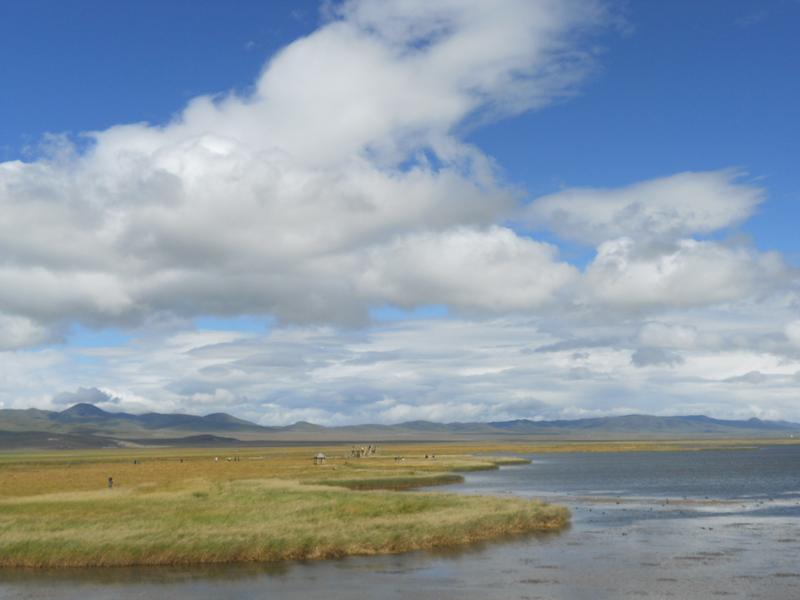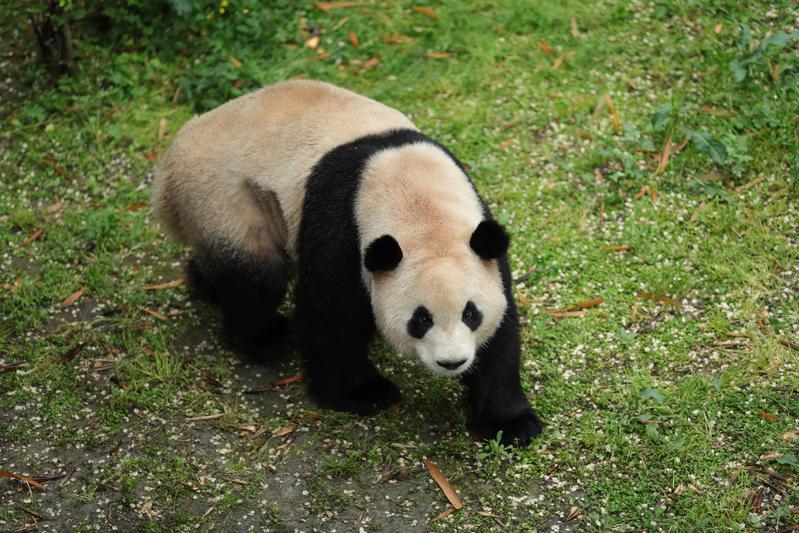 Both Jiajin Mountain and the Songpan Grasslands, where the Red Army soldiers climbed the snowy mountains and crossed the dangerous grasslands, appeal to today's visitors with pandas or stunningly beautiful natural scenery. (HUANG LERAN / FOR CHINA DAILY)
Both Jiajin Mountain and the Songpan Grasslands, where the Red Army soldiers climbed the snowy mountains and crossed the dangerous grasslands, appeal to today's visitors with pandas or stunningly beautiful natural scenery. (HUANG LERAN / FOR CHINA DAILY)
Mention of the Long March reminds people of the odyssey of the Red Army soldiers climbing the snowy mountains and crossing the dangerous grasslands.
"The Red Army soldiers climbed eight snowy mountains and the Songpan Grasslands, all of which are in Aba," says Jiang Zuquan, an information officer with the Aba prefecture committee of the Communist Party of China, in the Aba Tibetan and Qiang autonomous prefecture in Sichuan.
Soon after passing the Luding Bridge in the Ganzi Tibetan autonomous prefecture, the Red Army soldiers climbed Jiajin, the first snowy mountain.
Jiajin, which is more than 4,000 meters above sea level, is covered with snow all year round and has very thin air. The mountain has capricious weather, and there were no people or roads on it. According to a book on the Long March published by the Party History Press, the weather could change from being cloudy to sunny, rainy to snowy, and raining hailstones to being windy.
Most of the Red Army soldiers had no experience navigating icy terrain and their footwear were cloth shoes or straw sandals.
It was June, but a blizzard swept through the heights and the soldiers' thin clothing was quickly soaked. The biting cold and great difficulty in breathing brought havoc.
From the foot to Jiajin's last peak, several hundred people passed away during the 40-kilometer hike. They sat down to take a rest but could never stand up again, Dong Biwu, a Long March veteran, told American journalist Agnes Smedley in Yan'an, Shaanxi province, in 1937.
Located at the junction of the Qinghai-Tibet Plateau and Sichuan Basin, the Songpan Grasslands, or Zoige Marsh, is the largest plateau wetland in the world.
Covering about 15,200 square kilometers, the grasslands spanning Songpan, Hongyuan and Zoige counties in the Aba prefecture are covered with flowers in August. But lying behind the beautiful scenery was peril.
In some sections of the grasslands, water was knee-deep. Sometimes, a soldier got stuck and disappeared in the mire before fellow soldiers tried to pull him out with a puttee.
 (HUANG LERAN / FOR CHINA DAILY)
(HUANG LERAN / FOR CHINA DAILY)
The temperature could be as high as 30 C during the day. But by night, the temperature would drop to around 0 C. Soldiers had to place some grass on the wet land before sleeping, sitting with their backs resting against each other. At daybreak, many were found to have perished.
A squad of soldiers had slept in a rainstorm in the open air. When it was time for breakfast, the company commander shouted but none of them responded. When the commander approached, he found that they were not breathing, reads a passage from the book on the Long March.
In present time, both Jiajin and the grasslands appeal to visitors with pandas and stunningly beautiful natural scenery.
The West learned about the giant panda in 1869 from Jean Pierre Armand David, a French missionary working for the Dengchigou Catholic Church in Jiajin.
When he had tea at a local hunter's home, he saw the skin of a giant panda for the first time. Suspecting it to be a new animal species, he had the hunter capture a live panda, made its skin into a specimen and mailed it to the Musee d'Histoire Naturelle's Henri Milne Edwards in Paris.
Just 3 km from Dengchigou Catholic Church is the Baoxing County Giant Panda Cultural Publicity and Education Center which covers more than 20,000 square meters and houses two residents-28-year-old male panda Meng Xi and 29-year-old female panda Chuan Xing.
The grasslands are vibrant in April as migratory birds have returned, including flocks of black-necked cranes that have started to travel back in early March to breed and raise young birds.
More than 3,000 meters above sea level, the Flower Lake in the grasslands is frequented by visitors. It got its name because of the variety of blossoming flowers in and by the lake in late June and early July.
Visiting the Flower Lake is like going from the mortal to the immortal world, says Yi Feng, a 57-year-old local Tibetan. The crystal-clear water in the lake is filled with all kinds of water plants which emit fresh fragrance into the air.
Covering 213,333 hectares, the Flower Lake, which is a wetland, is home to the yellow duck, black-necked crane, gull, marmot, hare and plateau fish.


